Wildflowers of the Adirondacks:
Blue Flag (Iris versicolor)
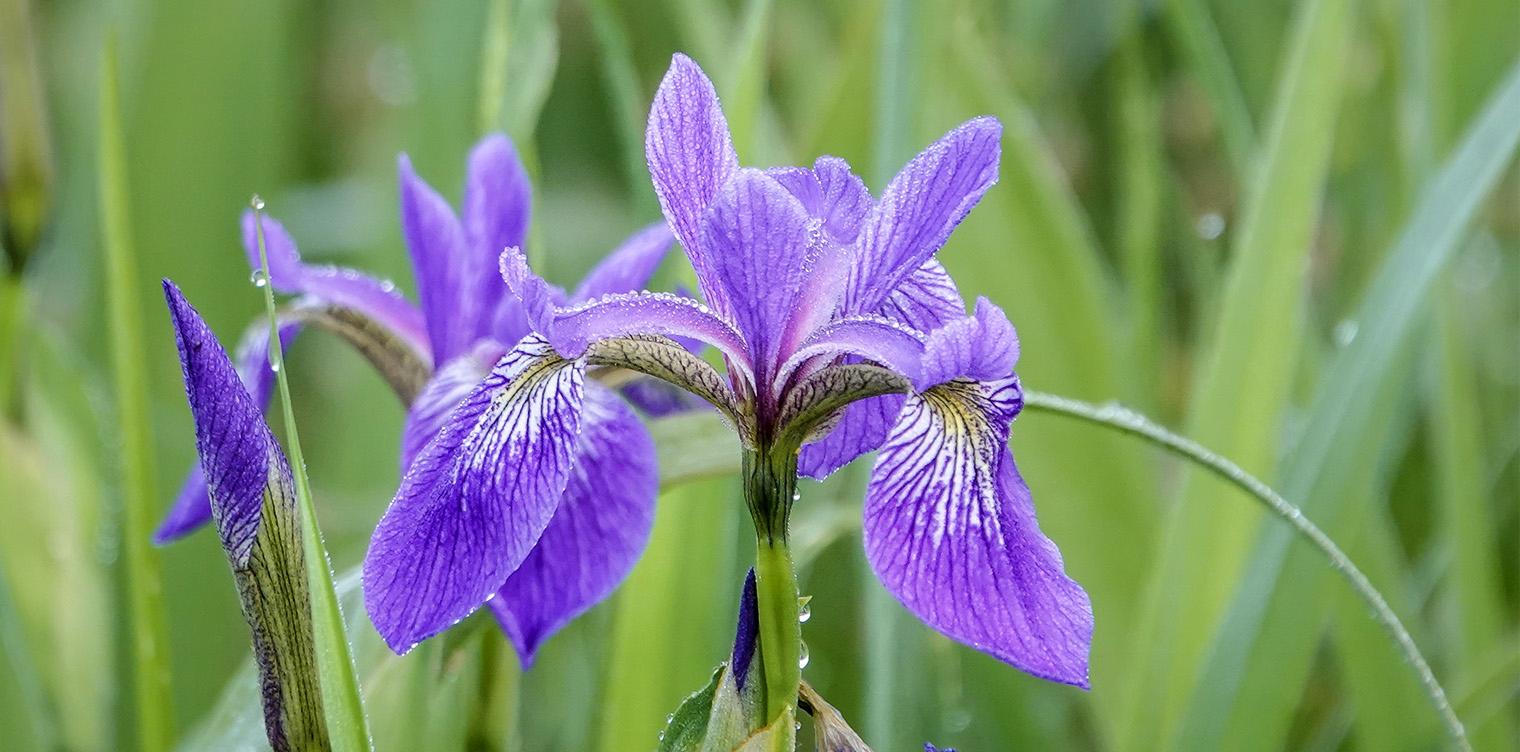
Blue Flag (Iris versicolor) is a native iris that grows in wetlands in the Adirondack Mountains of upstate New York. It produces showy violet-blue flowers in early summer.
This plant is also called Northern Blue Flag, Larger Blue Flag, Harlequin Blueflag, and Wild Iris. The name "flag" is from the middle English word "flagge," meaning rush or reed. Iris flowers are said to symbolize power, with the three parts representing wisdom, faith and courage.
Identification of Blue Flag
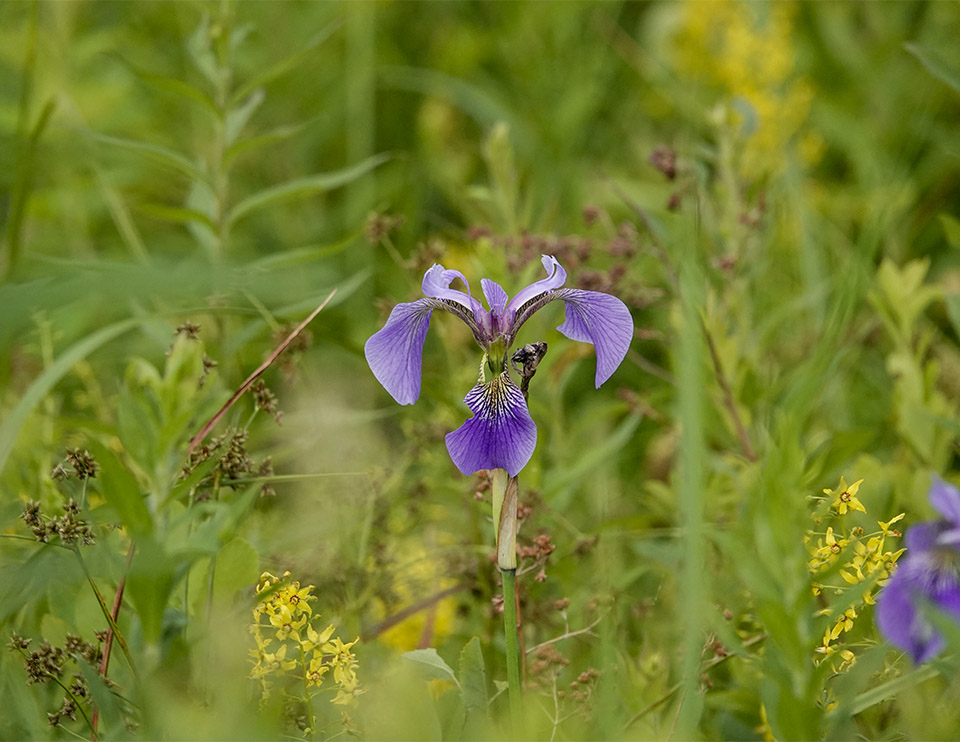
Blue Flag grows about 2-3 feet tall with long, narrow leaves (½ to 1 inch wide) of bluish green. The sword-like leaves are basalBasal: Leaves are confined to the base of the stem. , emerging from large, creeping rhizomes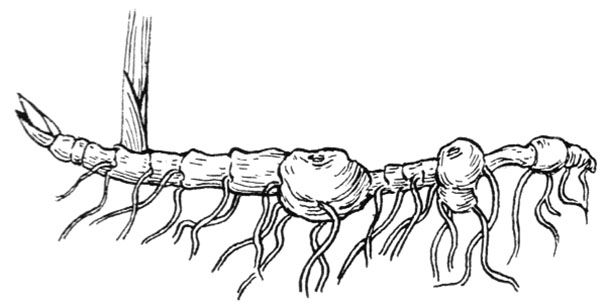 Rhizome: The modified subterranean stem of a plant that sends out roots and shoots from its nodes. Rhizomes are also called creeping rootstalks and rootstocks.. The leaves have veins
Rhizome: The modified subterranean stem of a plant that sends out roots and shoots from its nodes. Rhizomes are also called creeping rootstalks and rootstocks.. The leaves have veins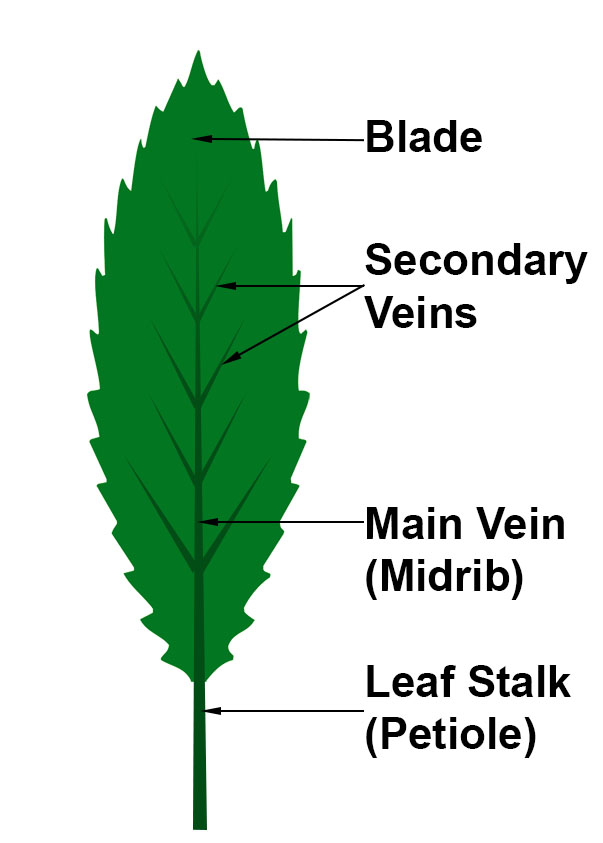 Vein: A vessel that conducts nutrients, sugars, and other substances throughout plant tissues; usually associated with leaves. The arrangement of veins in a leaf is called the venation pattern. and appear to be folded at the center.
Vein: A vessel that conducts nutrients, sugars, and other substances throughout plant tissues; usually associated with leaves. The arrangement of veins in a leaf is called the venation pattern. and appear to be folded at the center.
Blue Flag produces several striking, violet-blue flowers. The down-curved violet sepals.gif) Sepals: The parts that look like little green leaves and cover the outside of a flower bud to protect the flower before it opens. are veined in yellow and white. The flowers are 2½ to 4 inches wide.
Sepals: The parts that look like little green leaves and cover the outside of a flower bud to protect the flower before it opens. are veined in yellow and white. The flowers are 2½ to 4 inches wide.
Blue Flag flowers in early summer in the Adirondacks.
- A tally of flowering dates for the upland Adirondack areas compiled by Michael Kudish, based on data collected from the early seventies to the early nineties, lists 16 June as the earliest date of flowering and 27 June as the median date.
- The pattern of bloom dates from iNaturalist's Adirondack Park observations suggest that Blue Flag has been flowering in recent years from mid-June to mid-July.
The fruit of Blue Flag is a three-celled capsule about 1½ inches long and ¾ inch in diameter. The capsules often persists over winter. The seeds inside are dark brown.
Uses of Blue Flag
Blue Flag is considered to be poisonous if ingested. The roots are particularly toxic and can cause nausea and vomiting. Contact with the plant can also cause skin irritations in some people.
In the past, Blue Flag was a popular medicinal plant among some native American groups. Although Blue Flag is poisonous, Native Americans and colonists dried the rhizome of the plant and used it in small amounts as a cathartic and diuretic. In addition, some native Americans reportedly used the two outermost fibers of the leaves to spin twine. Powdered iris root has also been added to perfume and potpourri.
Wildlife Value of Blue Flag
Blue Flag has limited value as a food source for wildlife. Several non-pollinating nectar feeders are frequent flower visitors, including Harris Checkerspot and Hobomok Skipper. Blue Flag also attracts bees and hummingbirds.
Blue Flag plants are pollinated by bees and, like other plant species pollinated by bees, have evolved special types of flowers that are easy for bees to find. Blue Flag has large lobes that bees use as landing platforms and special markings directing bees to the nectar glands.
Distribution of Blue Flag
The native distribution of Blue Flag includes the northeastern part of the US, south to Virginia. In Canada, its distribution spans from Newfoundland to Manitoba.
In New York State, Blue Flag is found in nearly all counties in the eastern part of the state. It has been documented growing in all counties within the Adirondack Park Blue Line.
Habitat of Blue Flag
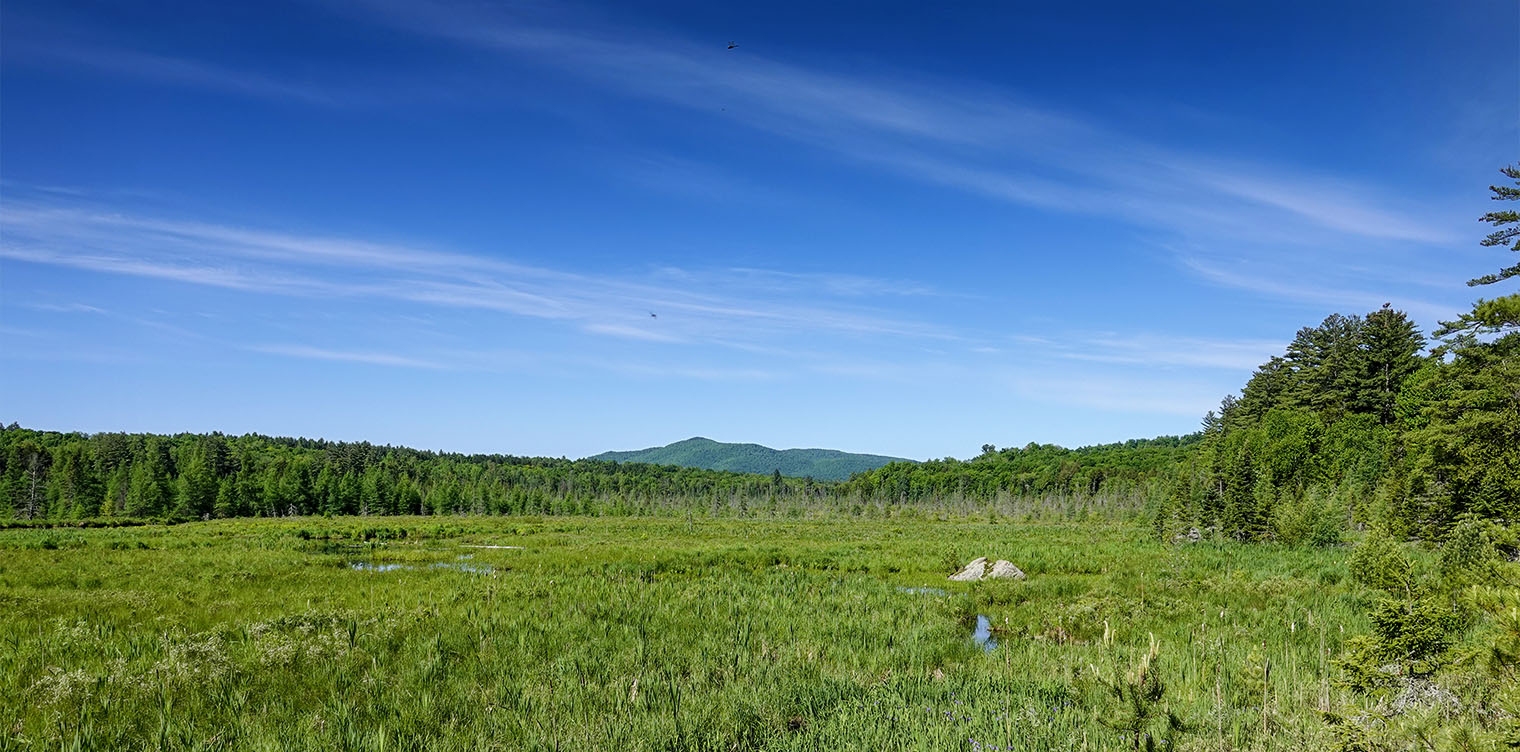
Blue Flag is classified as an Obligate Wetland (OBL) plant, meaning that it almost always occurs in wetlands. It grows in poorly drained soils and the shallow water on the periphery of marshes and bogs, on both open sites and wooded edges. It is also found in wet meadows, on the shores of streams, rivers, ponds, and lakes, and in drainage ditches. It is shade intolerant. It will tolerate water to a depth of one to two feet.
This plant is abundant in several ecological communities in the Adirondack Park, including:
One of the most convenient places to study this plant is Heron Marsh at the Paul Smith's College VIC, where it grows on the edges of the marsh, together with cattails and sedges. Listen for a chorus of amphibians that breed on shallow emergent marshes, including Spring Peeper, Green Frog, and Wood Frog. Birds commonly seen flitting about Blue Flag plants include Swamp Sparrow, Common Yellowthroat, and Red-winged Blackbird.
References
Michael Kudish. Adirondack Upland Flora: An Ecological Perspective (The Chauncy Press, 1992), pp. 23-28, 233.
New York Flora Association. New York Flora Atlas. Blue Flag. Iris versicolor L. Retrieved 18 March 2017.
United States Department of Agriculture. The Plants Database. Harlequin Blueflag. Iris versicolor L. Retrieved 18 March 2017.
United States Department of Agriculture. NRCS National Plant Data Center & the Biota of North America Program. Plant Fact Sheet. Blue Flag. Retrieved 18 March 2017.
United States Department of Agriculture. US Forest Service. Our Native Irises: Blue Flag Irises. Retrieved 9 February 2020.
Flora of North America. Blue Flag. Iris versicolor. Retrieved 18 March 2017.
New York State. Department of Environmental Conservation. New York Natural Heritage Program. Ecological Communities of New York State. Second Edition (March 2014), pp. 48-49. Retrieved 17 October 2015.
New York Natural Heritage Program. 2021. Online Conservation Guide for Medium Fen. Retrieved 30 June 2021.
New York Natural Heritage Program. 2021. Online Conservation Guide for Rich Graminoid Fen. Retrieved 30 June 2021.
New York Natural Heritage Program. 2021. Online Conservation Guide for Rich Shrub Fen. Retrieved 30 June 2021.
New York Natural Heritage Program. 2021. Online Conservation Guide for Shallow Emergent Marsh. Retrieved 30 June 2021.
New York Natural Heritage Program. 2021. Online Conservation Guide for Silver Maple-Ash Swamp. Retrieved 30 June 2021.
New York State. Adirondack Park Agency. Preliminary List of Species Native Within the Adirondack Park Listed Alphabetically by Scientific Name and Sorted by Habit. Volume 1. Updated 10.23.2006. Retrieved 26 January 2017.
Cornell Lab of Ornithology, Ithaca, New York. All About Birds. Swamp Sparrow, Common Yellowthroat, Red-winged Blackbird. Retrieved 9 February 2020,
Lady Bird Johnson Wildflower Center. Iris versicolor. Retrieved 9 February 2020.
Native Plant Trust. Go Botany. Blue Iris. Iris versicolor L. Retrieved 30 June 2021.
iNaturalist. Northern Blue Flag. Iris versicolor. Retrieved 30 June 2021.
iNaturalist. Adirondack Park Observations. Northern Blue Flag. Iris versicolor. Retrieved 9 February 2020.
Plants for a Future. Blue Flag. Retrieved 9 February 2020.
University of Michigan. Native American Ethnobotany. A Database of Foods, Drugs, Dyes and Fibers of Native American Peoples, Derived from Plants. Iris versicolor L. Harlequin Blueflag. Retrieved 18 March 2017.
John Eastman. The Book of Swamp and Bog: Trees, Shrubs, and Wildflowers of Eastern Freshwater Wetlands (Stackpole Books, 1995).
Anne McGrath. Wildflowers of the Adirondacks (EarthWords, 2000), pp. 60, 89.
Doug Ladd. North Woods Wildflowers (Falcon Publishing, 2001), p. 47.
Lawrence Newcomb. Newcomb's Wildflower Guide (Little Brown and Company, 1977), pp. 120-121.
Roger Tory Peterson and Margaret McKenny. A Field Guide to Wildflowers. Northeastern and North-central North America (Houghton Mifflin Company, 1968) pp. 314-315.
Donald D. Cox. A Naturalist's Guide to Wetland Plants. An Ecology for Eastern North America (Syracuse University Press, 2002), pp. 53-54.
Ronald B. Davis. Bogs & Fens. A Guide to the Peatland Plants of the Northeastern United States and Adjacent Canada (University Press of New England, 2016), pp. 176-177.
William K. Chapman, et al. Wildflowers of New York in Color (Syracuse University Press, 1998), pp. 122-123.
National Audubon Society. Field Guide to Wildflowers. Eastern Region. (Alfred A. Knopf, 2001), pp. 571-572, 611.
Charles H. Peck. Plants of North Elba. (Bulletin of the New York State Museum, Volume 6, Number 28, June 1899), p. 131. Retrieved 22 February 2017.
